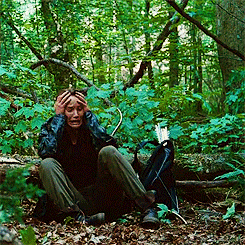An enormous panorama (8032 x 2024) of an outcrop of Tyee turbidites, just east of Eddyville, OR. The above image is linked to the full-sized image, hosted at Flickr; alternatively,
you can view the image here, and right click on it for various size options.
Soon after the oceanic plateau/seamount terrane of the Siletz River Volcanics formed (Siletzia), its (now) southern (then eastern) end moved to within close enough proximity to North America that the area began to receive and accumulate continental sediment from the Klamath Mountain region. As the docking process initiated and continued, these sediments accumulated to greater thickness in the Roseburg area, where Chris Rowan (
@Allochthonous) and I visited them on Tuesday.
The drainage supplying that sediment apparently captured a large stream that was eroding the Idaho Batholith, and the nature of the sediment changed from dominantly lithics (the Flournoy Formation) to sands dominated by feldspar and mica (the Tyee Formation), as one would expect from a granitic landscape. This new sediment accumulated in a large deltaic fan. Occasionally, perhaps on the order of decades to centuries, a portion of that fan would collapse and slide into deeper water. These so-called turbidites might have been triggered by earthquakes, unusually large storms, or simply by over-steepening of the sediment pile.
As they moved downhill, these submarine slides would disaggregate, entrain water, and become what I describe as underwater sand and dust storms. The turbid water rushed down the slope until it reached the bottom, where it ran out of energy and the sediment began to settle out. The coarsest material, the sands, settled out first, in a matter of hours to maybe a day or so, followed by finer silts and muds over a period of days to weeks and months. So turbidites generally, and the above specifically, are characterized by rhythmically stacked couplets of sandstone and mudstone, repeating thousands of times through the entire sequence. Though we're only seeing around a dozen of these couplets in the above outcrop, it provides an impressive window into the history of the Oregon Coast Range.
@Allochthonous, in the lower center provides a sense of scale.
Photo stitched in Hugin, otherwise unmodified. July 3, 2013.
FlashEarth location














































